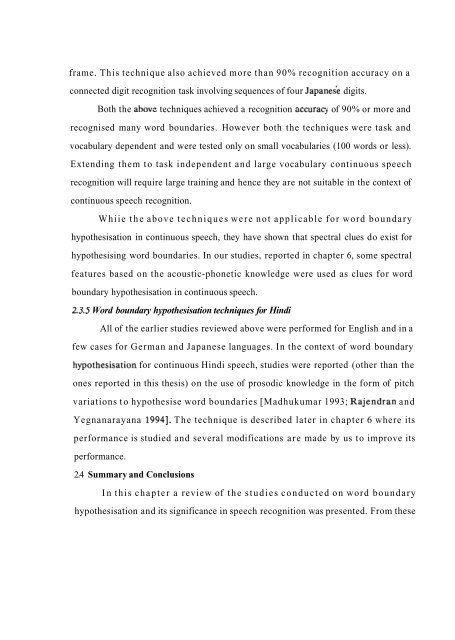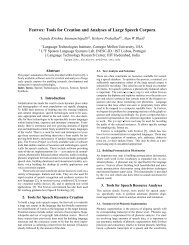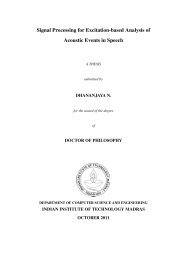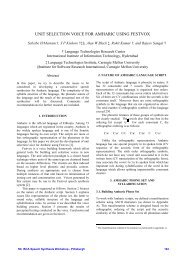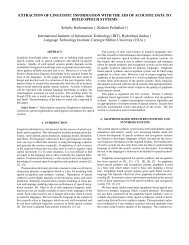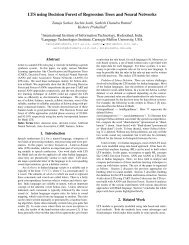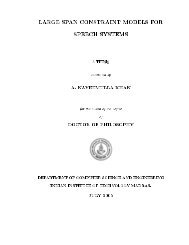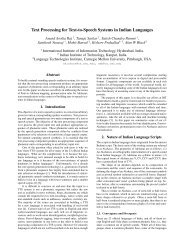word boundary- hypothesisation in hindi speech - Speech and ...
word boundary- hypothesisation in hindi speech - Speech and ...
word boundary- hypothesisation in hindi speech - Speech and ...
Create successful ePaper yourself
Turn your PDF publications into a flip-book with our unique Google optimized e-Paper software.
frame. This technique also achieved more than 90% recognition accuracy on a<br />
connected digit recognition task <strong>in</strong>volv<strong>in</strong>g sequences of four ~a~anesk digits.<br />
Both the abovz techniques achieved a recognition accuracy of 90% or more <strong>and</strong><br />
recognised many <strong>word</strong> boundaries. However both the techniques were task <strong>and</strong><br />
vocabulary dependent <strong>and</strong> were tested only on small vocabularies (100 <strong>word</strong>s or less).<br />
Extend<strong>in</strong>g them to task <strong>in</strong>dependent <strong>and</strong> large vocabulary cont<strong>in</strong>uous <strong>speech</strong><br />
recognition will require large tra<strong>in</strong><strong>in</strong>g <strong>and</strong> hence they are not suitable <strong>in</strong> the context of<br />
cont<strong>in</strong>uous <strong>speech</strong> recognition.<br />
Whiie the above techniques were not applicable for <strong>word</strong> <strong>boundary</strong><br />
<strong>hypothesisation</strong> <strong>in</strong> cont<strong>in</strong>uous <strong>speech</strong>, they have shown that spectral clues do exist for<br />
hypothesis<strong>in</strong>g <strong>word</strong> boundaries. In our studies, reported <strong>in</strong> chapter 6, some spectral<br />
features based on the acoustic-phonetic knowledge were used as clues for <strong>word</strong><br />
<strong>boundary</strong> <strong>hypothesisation</strong> <strong>in</strong> cont<strong>in</strong>uous <strong>speech</strong>.<br />
2.3.5 Word <strong>boundary</strong> <strong>hypothesisation</strong> techniques for H<strong>in</strong>di<br />
All of the earlier studies reviewed above were performed for English <strong>and</strong> <strong>in</strong> a<br />
few cases for German <strong>and</strong> Japanese languages. In the context of <strong>word</strong> <strong>boundary</strong><br />
<strong>hypothesisation</strong> for cont<strong>in</strong>uous H<strong>in</strong>di <strong>speech</strong>, studies were reported (other than the<br />
ones reported <strong>in</strong> this thesis) on the use of prosodic knowledge <strong>in</strong> the form of pitch<br />
variations to hypothesise <strong>word</strong> boundaries [Madhukumar 1993; Rajendran <strong>and</strong><br />
Yegnanarayana 19941. The technique is described later <strong>in</strong> chapter 6 where its<br />
performance is studied <strong>and</strong> several modifications are made by us to improve its<br />
performance.<br />
2.4 Summary <strong>and</strong> Conclusions<br />
In this chapter a review of the studies conducted on <strong>word</strong> <strong>boundary</strong><br />
<strong>hypothesisation</strong> <strong>and</strong> its significance <strong>in</strong> <strong>speech</strong> recognition was presented. From these


